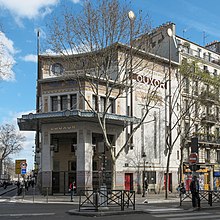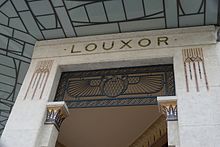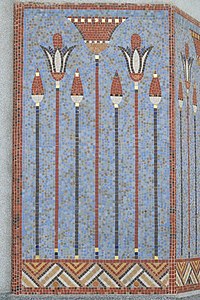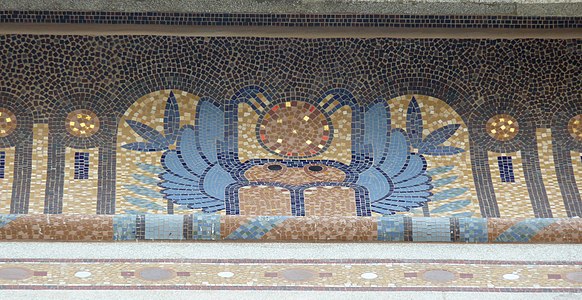Le Louxor
Le Louxor is a cinema that reopened in 2013 at corner 170, Boulevard de Magenta / 53, Boulevard de la Chapelle in the 10th arrondissement in Paris . The house was opened on October 6, 1921, based on a design by the architect Henri-André Zipcy , born in Algeria in 1873 . The house has been closed to the public since the end of 1983. It is a remarkable testimony to architecture in the interwar period and has been classified as a Monument historique since 1981 . In April 2013 the Louxor was reopened as a cinema (three halls) according to its original purpose after many years, carried out by the city of Paris.
history
On the site of the cinema building, a few steps from the Boulevard Barbès metro station , was a department store built by Georges-Eugène Haussmann until 1921 . Owner of cinema was Henry Silberberg, who showed great courage and vision with this new building to have a fully functional, 30-year-old buildings torn down to there by an unknown architect in times of deflation, a movie palace in neo-Egyptian style to build. The Le Louxor cinema was named after the Upper Egyptian city of Luxor .
The house was described in press and contemporary witness reports as extremely magnificent: Allegorical figures of the Egyptian imagery were to be discovered everywhere , most of which are still present today. The canvas closed three different velvet curtains in the colors black, red and blue. The cornices , balconies and the coffered ceiling were richly decorated and the floor was closed by a thick carpet. The 1,090 seats - including about 140 folding seats - were made of mahogany wood , the seat and the back were upholstered with velvet. According to current estimates, the investment in decoration is likely to have been around 4000 francs per square meter of floor space.
Its owner no longer had any influence on the fate of the cinema, because it died that same year. In April 1922, his widow had to file for bankruptcy and sell the house for over 1.5 million francs. In May 1922 it went to the newly founded Société Nouvelle du Cinéma Louxor . Seven years later, on April 24, 1929, the Société de Gérance des cinémas Pathé (SGCP) took over the cinema, a company that had 20 movie theaters in Paris. The first task was to replace the lighting, ventilation and heating system. In addition, the neo-Egyptian style was converted into neo-Greek style. Further renovations took place in 1954 and 1964, when the cinema hall got widescreen format and a new sound system.
In the 1970s and 1980s, due to the population structure that had changed in the meantime, the cinema dedicated itself to the Bollywood theme with current Indian, Arab and Egyptian original productions , thus indirectly returning to its Egyptian orientation.
After its closure as a cinema, the cheap fashion chain Tati moved first one for a few years before 1987, a building in the gay - Disco opened. This trade was also short-lived because the house was to be sold. Several times, sales failed, sometimes at the last moment. Rumors of a possible sale circulated again and again. In December 2001, the Action Barbès initiative was founded to save the building as a cinema. In April 2002 this resulted in the Sauvons le Louxor citizens' initiative . As a successor, Les amis du Louxor has been representing the local residents' cultural interests since 2007 . The renovation work on the exterior facade began in September 2010. The architect for the renovations and renovations is Philippe Pumain . The reopening took place on schedule in April 2013.
Mosaics
The mosaics were made by Gentil & Bourdet.
Le Louxor in the novel
The cinema also became the material for literary representations: In Daniel Crozes ' novel “L'Alouette”, published in 2004, the house is twice the scene of events. Jakuta Alikavazovic had the cinema in Le Londres-Louxor , which appeared in 2010, notionally in the Paris district of Barbès, and not, as one would expect from the title of the novel, in London .
literature
- Jean-Marcel Humbert: Les monuments égyptiens et égyptisants de Paris. In: Bulletin de la Société française d'égyptologie. No. 62, October 1971, p. 27
- Jean-Jacques Meusy: Palaces and Holes in the Wall. Conditions of Exhibition in Paris on the Eve of World War I. Velvet Light Trap, 1996
- The Failure and Success of Innovations, the Case of CinemaScope. In: Jean-Jacques Meusy (Ed.): Le Cinémascope entre Art et Industrie. CinemaScope Between Art and Industry. Paris 2003, pp. 153-163
Web links
- Official website
- Action Barbès ( Memento from September 11, 2010 in the Internet Archive ) with many pictures and texts about the house (French)
- Pictures of the interior after the disco closed
- Historical background with other web links
- Le Louxor, renaissance d'un immense cinema
Individual evidence
- ^ Advertisement in Le Figaro dated October 6, 1921
- ↑ a b c d e Les Amis du Louxor: Chronology 1921–2010.
- ↑ Les Amis du Louxor: 1922. Madame Silberberg vend le Louxor.
- ↑ Les Amis du Louxor: September 2010. Le mot de la rentrée.
- ↑ http://de.structurae.de/structures/data/index.cfm?ID=s0040041
Coordinates: 48 ° 53 '0.6 " N , 2 ° 20' 59.3" E






